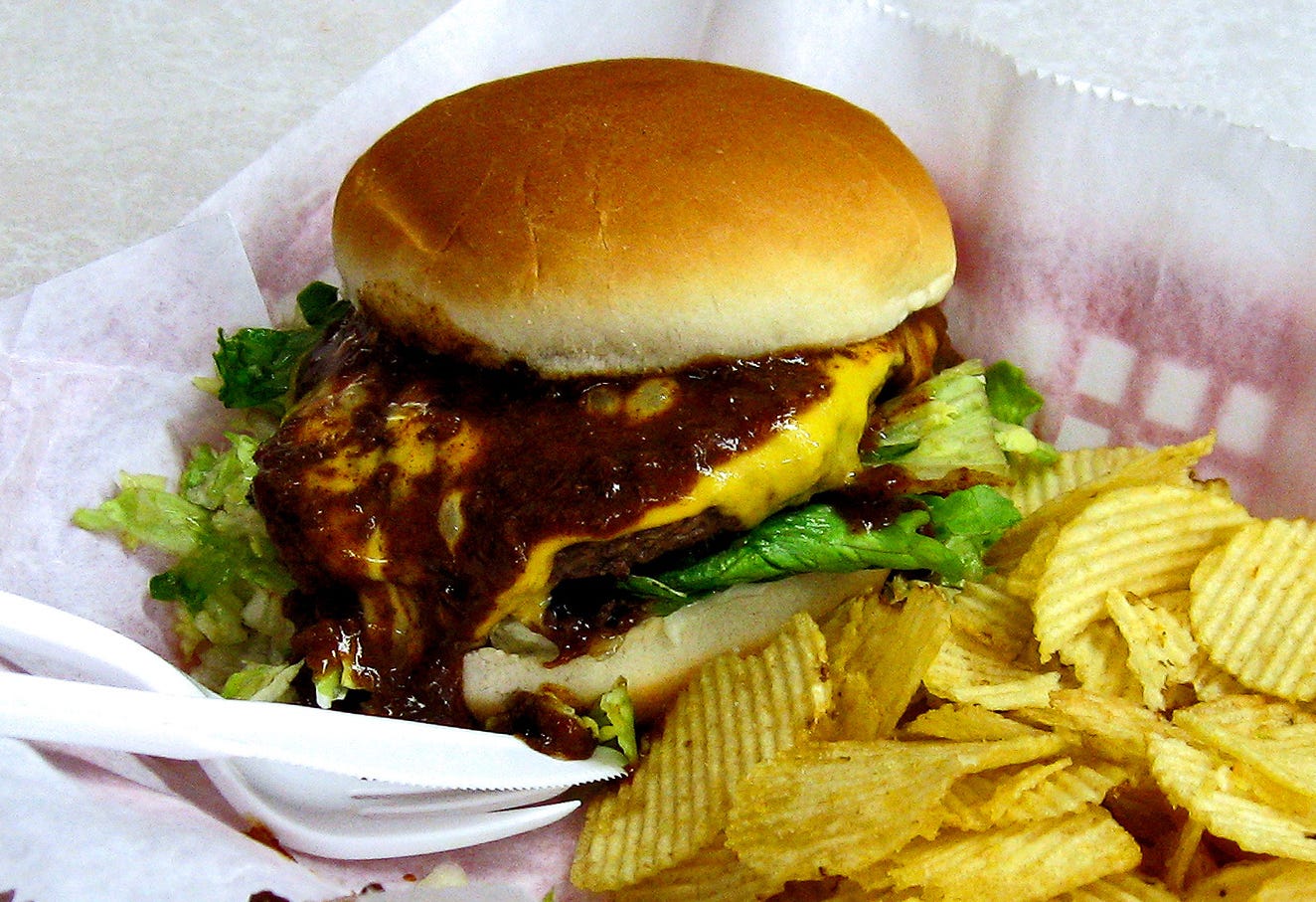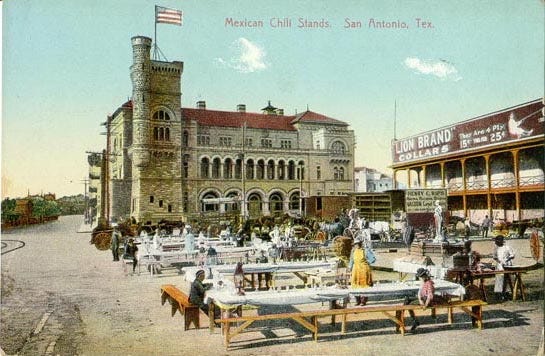Notable Sandwiches #38: The Chiliburger
A Los Angeles favorite seems like too much of a good thing
Welcome to Notable Sandwiches, the series in which we trip merrily through the profoundly odd and ever-changing document that is Wikipedia’s List of Notable Sandwiches. This week, David writes about the first hamburger to appear on the list: the chiliburger. — Talia
I must confess, I don’t get the chiliburger. I love hamburgers, and cheeseburgers even more. But putting chili on a hamburger seems like putting a hat on a hat, or gilding the lily. Only you’re putting a bowler on top of a derby, or gilding the lily with more lily petals. Ground beef is fine. But ground beef on top of ground beef strikes me as an exercise in redundancy (not unlike the saddest entry on the entire Wikipedia list: the toast sandwich.) Would you put meatballs in your bolognese?
On the other hand, we at least have some idea of the origin of the chiliburger, which is more than we can say for some of the sandwiches we’ve encountered thus far.
Thomas “Ptomaine Tommy” De Forest arrived in Los Angeles in 1912, a young Okie transplant looking to pay his way through law school by slinging hash at the six-stool lunch wagon he purchased on arrival. A stint as an Army mess sergeant during World War I took him to Texas for a few years, but when he returned to L.A., De Forest opened an additional brick-and-mortar location, and then another by the end of the decade. It was here—in a saw-dust floored, taxidermy-festooned hole-in-the-wall—that he began ladling out his iconic chili “size.” An open-faced burger patty, smothered in chili con carne, cheese, and onions, it wasn’t quite what we think of as a standard chiliburger today, but it was cheap, tasty, and the location soon became a favorite of big-time politicians, prizefighters like Max Baer, and Hollywood stars like Mae West and Mary Pickford. By the time he closed Ptomaine Tommy’s in 1958, De Forest was a newspaper column staple, and his signature dish had become a Los Angeles icon.
“It’s the result of two distinct stories colliding,” says Andrew Smith, food historian and author of Hamburger: A Global History, who I spoke to this week. “The first is the rise of Mexican-American food—which has little to do with actual Mexican food. The second, of course, is the hamburger.”
As Smith notes in his book, credit for the invention of the standard hamburger—sans chili—has been claimed by countless municipalities throughout America, including: Athens, Texas; Seymour, Wisconsin; Hamburg, New York; and New Haven, Connecticut. But, as Smith notes, “each of these cases has one thing in common: no primary evidence has surfaced to support its claims.” Smith, instead, credits an unknown street vendor, likely in 19th Century Chicago, which was home to the American meat-packing industry, and to a large German population. Hamburg steak—chopped or ground beef formed into patties, then fried, grilled, or broiled—had been around for decades, and gained widespread popularity at the Philadelphia Centennial Exhibition in 1876. It was only a matter of time before some enterprising cook put the patty between two pieces of bread.
The history of chili is similarly vague. In 1828, a Yankee emigré to Mexico named Joseph Chambers Clopper described eating a local chili-like stew “with nearly as many peppers as there were pieces of meat.” This would seem to be ancestor to the dish we know today. By mid-19th century, so-called “Chili Queens” crowded San Antonio’s central plaza to feed the hungry gringos. The novelist Stephen Crane wrote about the Queens and their spicy specialty in 1885: “Mexican Vendors with open-air stands sell food that tastes exactly like pounded fire-brick from Hades.” A spot of their chili was a red badge of courage, indeed.
But, as Andrew Smith notes, chili as we know it today is a Mexican-American dish, not a Mexican one. And it was William Gebhardt, a German immigrant to New Braunfels, Texas, who had the idea of recreating the Chili Queens’ exotic flavor profile by combining dried poblano peppers, black pepper and oregano extracts, fresh garlic, ground cumin, and ground oregano. The result—an all-in-one chili powder, which Gebhardt introduced in 1895—could be added to sizzling ground beef for homemade chili. It swept the nation.
The fact that chili and the hamburger should collide in Los Angeles makes all the sense in the world. After all, if Texas has any rival as the home of Mexican-American cuisine, it’s probably Southern California. And while we don’t know who exactly invented the hamburger, there can be little doubt that Los Angeles is—in the words of the New York Times—“The Hamburger capital of the world.”
The Sword and the Sandwich is a newsletter about serious extremism and equally serious sandwiches. Please consider supporting this work with a paid subscription:
In addition to McDonald’s—which opened in 1940—Los Angeles has given the world national franchises like Bob’s Big Boy, Carl’s Junior, and Johnny Rockets; local chains like In & Out; and old-time landmarks like the Apple Pan and Pie & Burger. “We own the hamburger. L.A. is burgertown, U.S.A.,” wrote Charles Perry in the Los Angeles Times. “It’s the food of the car culture that has been the estate of L.A. youth since the 1940s. Going to the burger stand or drive-in suggests the whole James Dean, ducktail haircut, ‘American Graffiti’ state of mind.”
“The hamburger obviously was an important part of suburban culture,” says Smith. “I grew up in the San Fernando Valley, and I don’t know if you know what L.A. was like after World War II, but it was filled with suburban areas, and there was no food! People didn’t have a lot of money, and if you needed to eat out, or if you didn’t have a kitchen, a hamburger joint was one of the places to get something really cheap. A burger at McDonalds cost 15 cents. That’s why my parents ended up going there—because it was cheap and kids loved it. We’d go to McDonalds and get our burgers, and then go to a drive-in movie theater.”
Over six decades after Thomas De Forest closed his namesake restaurant, the name Tommy is still evokes “chiliburger” in much the same way that Ray’s (“Famous,” “Original” or otherwise) evokes “utility slice” in New York City. In 1946—twelve years before De Forest hung up his ladle—an entrepreneur named Tom Koulax opened Original Tommy’s World Famous Hamburgers. Today it has 33 locations, and even more imitators. According to a 2019 Los Angeles Times investigation, “there are 67 restaurants in and around L.A. County that appear to be knockoffs,” including Tomy’s Hamburgers, Tom’s Number 5 Chiliburgers, Tam’s Burgers, Tommy’s Famous Drive-Thru, Thomas Hamburgers, Tom’s #1 World Famous Chiliburgers, Tomboy’s Famous Chili Hamburgers, Tom’s Jr. Famous Chili Burgers, Tom’s Original Super Burger, Tommy’s Charbroiled Hamburgers, and Tommy’s Burgers. All of them are located in and around Los Angeles, all are named after some variation of “Thomas,” and all specialize in chiliburgers.
So Ptomaine Tommy De Forest’s legacy lives on along with his name, which is a strange thing when you think about it. If you’re smarter than I am you may already know that “ptomaine” connotes nothing so much as food poisoning. It’s hard to imagine a worse name for a restaurant. And, as a local newspaper reported in a front page story on the closing, De Forest had only himself to blame. “No, it wasn’t a retching customer who tagged him with the ‘ptomaine’ sobriquet. ‘I did it myself as a matter of foolishness,’ he confided, ‘and the name stuck.” Thankfully it was his given name and not his nickname that stuck to the chiliburger, that hat on a hat, Los Angeles County’s gilded lily.









